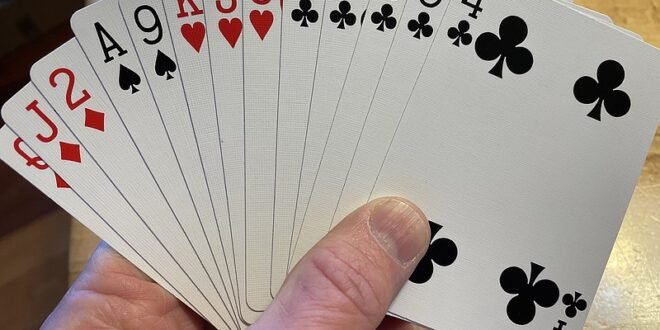Spades is a classic card game that has captivated players for generations. Its blend of strategy, skill, and a bit of luck makes it a favorite among card enthusiasts. Whether you’re a beginner looking to learn the basics or an experienced player aiming to refine your strategy, this guide will provide you with a comprehensive overview of how to play Spades.
Understanding the Basics
Before diving into the nuances of strategy, it’s essential to grasp the fundamental rules of Spades. The game is typically played by four players, divided into two teams. Players sit across from their partner at a table, creating a competitive yet cooperative dynamic that’s unique to team-based card games.
The Deck and Deal
Spades is played with a standard 52-card deck. Each player is dealt 13 cards, ensuring the entire deck is distributed at the start of each round. The dealing process is straightforward: cards are dealt one at a time in a clockwise direction until all players have their hands.
Objective of the Game
The primary objective in Spades is for each team to score points by bidding on and winning tricks. A “trick” consists of each player laying down one card, with the highest card of the leading suit winning, unless a Spade is played. Spades are always the trump suit, meaning they outrank all other suits. The game continues until one team reaches the agreed-upon score, typically 500 points, declaring them the winner.
The Bidding Phase
At the beginning of each round, after the cards are dealt, players participate in a bidding phase. During this phase, each player predicts how many tricks they believe they can win based on the strength of their hand. This prediction is crucial as it sets the goal for the team for that round.
Strategy in Bidding
Effective bidding requires a balance between ambition and caution. Overbidding can be risky; if a team fails to meet their bid, they face penalties. Conversely, underbidding might limit a team’s scoring potential. Successful players often develop an intuitive sense of when to bid aggressively and when to adopt a more conservative approach.
Gameplay Dynamics
Following the bidding phase, the game moves into the trick-taking segment. The player to the dealer’s left leads the first trick by playing any card except for a Spade, unless their hand is composed solely of Spades. Play continues clockwise, with each player adding one card to the trick.
Leading and Following Suit
Players must follow the suit of the first card played in each trick if possible. If a player cannot follow suit, they may play a Spade or any other suit if Spades have not yet been “broken” (played). The highest card of the lead suit wins the trick unless a Spade is played, in which case the highest Spade wins.
Spades and Strategy
The introduction of Spades into play adds a strategic depth to the game. Deciding when to play your Spades, whether to attempt to “cut” a trick by playing a high Spade when unable to follow suit, or to hold them back for future tricks, is a critical decision that can significantly impact the outcome of the game.
Scoring and Winning
After all 13 tricks have been played, the score for the round is calculated. Teams score 10 points for each trick bid and won. Additional tricks won beyond the bid are called “bags” and are worth one point each. However, accumulating too many bags can lead to penalties.
Managing Bags and Penalties
An essential aspect of advanced Spades strategy is managing your team’s bags. Accumulating 10 bags results in a 100-point penalty, a significant setback. Skilled players keep a careful tally of bags, sometimes even deliberately losing tricks to avoid incurring penalties.
Advanced Tips and Techniques
As players become more familiar with the basics of Spades, they can begin to explore advanced strategies. These might include signal plays to communicate with your partner, strategic bidding to confuse opponents, or calculated risks based on the game’s progress and score.
Communication and Partnership
Success in Spades relies heavily on the partnership between teammates. Effective communication—whether through gameplay, legal signals, or understanding each other’s playing style—can significantly enhance a team’s performance.
Conclusion
Spades is a game of both skill and strategy, with a rich depth of gameplay that can take years to master fully. By understanding the basics, honing your bidding tactics, and learning to communicate effectively with your partner, you can improve your game and enjoy the intricate dynamics that make Spades a beloved pastime for so many. Whether you’re playing casually with friends or competing in more formal settings, the journey of mastering Spades is a rewarding one, filled with both challenges and triumphs.
Frequently Asked Questions About Playing Spades
1. How many people can play Spades?
Spades is traditionally played by four people, divided into two teams of two. However, variations of the game can accommodate different numbers of players, including solo and three-player versions.
2. What is the role of the trump suit in Spades?
In Spades, the trump suit is always Spades itself. This means that any card of the Spades suit beats any card of another suit during a trick. The strategic use of Spades is a crucial part of gameplay, as these cards can be used to win tricks that might otherwise be lost.
3. How do you decide who deals first in Spades?
The first dealer can be chosen through a random method, such as drawing cards with the highest card earning the deal, or through mutual agreement among players. After the first hand, the deal typically rotates clockwise around the table.
 Inspirescroll
Inspirescroll




